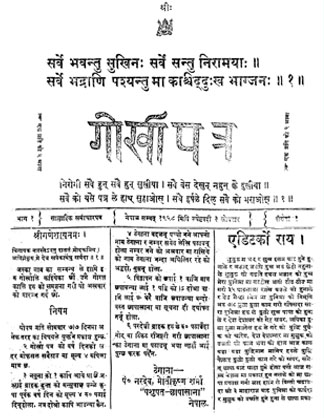
The world got it first regularly appearing printed newspaper in 1605. The ‘Relation aller Furnemmen und gedenckwurdigen Historien’, German, was published by Johann Carolus (1575-1634) in Strasbourg. Around three centuries later, in 1998, newspaper publication began in Nepal with the Sudha Sagar. Since then, the growth of Nepali newspapers has gone parallel with the political situation of the country.
However, the growth of online media has posed a challenge to the existence of Nepali newspapers, with some media critics fearing the industry would collapse soon along with speedy digitisation at the global level. They assume though the history of Nepali newspapers began 300 years late than it began in the world, it would follow the global trend soon as much as the downfall is concerned.
Here is a brief history of newspapers in Nepal as described by Bhanubhakta Acharya, a research scholar affiliated with the Department of Communications at the University of Ottawa in his book ‘Mass Communication and Journalism’, and brief analysis of its future by some media critics in Kathmandu.
Prior-Gorkhapatra period (1851-1901)
The journey of Nepali newspapers and magazines began in 1886 with the publication of Gorkha Bharat Jeewan in Banaras, India. It was the first Nepali-language magazine in the world. The editor of this monthly literary magazine was Ram Krishna Barma. To date, no one had found any printed copies of this magazine.
After this, in 1898, Sudha Sagar, a monthly literary magazine, was published by Pashupat Press in Nepal. This was the first printed media outlet from Nepal whose editors were Pandit Naradev Pandey, Moti Krishna Sharma, and Kapil Dev. Just like Gorkha Bharat Jeewan, there is not any printed copy of Sudha Sagar also.
Gorkhapatra and Rana regime (1901-1951)
Unlike other Rana prime ministers, Dev Shumsher JBR is considered liberal, concerned about the development of education in the country. He felt it necessary to have a regular newspaper in the country to inform the citizens. Giving his thought a firm shape, he started the publication of Gorkhapatra on May 6, 1901. It was published weekly and was edited by Pandit Naradev Pandey under the supervision of Lt Col Dilli Samsher Thapa. Gorkhapatra heralded the era of newspaper publication began in Nepal.

A few weeks later, Dev Shumsher’s brother Chandra Shumsher overtook the government. Then, he handed over the responsibility of Gorkhapatra to the King of Bajhang, Jaya Prithvi Bahadur Singh.
In Chandra Shumsher’s 31-year long regime, Gorkhapatra suffered a lot. During his tenure, in some situations, only five to 10 copies of the paper were published. Meanwhile, in 1934, the newspaper began to print the editor’s name also.
It was made bi-weekly in 1943 AD and tri-weekly the next year.
During the regime of Juddha Shumsher JBR, the publication of Sharada, a monthly literary newspaper, was also started in 1935. After a year, Surya Bhakta Joshi started the publication of Udyog fortnightly as an editor. Earlier, it was an industrial journal but later transformed into a literary magazine.
Likewise, magazines like Sahitya Srot (1947), Gharelu Ilam (1947), Shiksha (1947), Kathmandu Municipal (1947), Ankha (1948) and many more monthly and fortnightly newspaper were published. All of these were non-political publications, most of them literary.
Newspapers and other publications were out of the public reach during the Rana regime. They just acted as mouthpieces of the Ranas who were afraid that the publications would make the public aware and voice up against the cruel Rana regime.
Democracy (1951-1960)
After the establishment of democracy in 1951, the interim constitution guaranteed the right to freedom of expression and publication. Just one day after the proclamation of democracy by King Tribhuwan, the first daily newspaper of Nepal, Awaaj, was published on February 19, 1951, from Kathmandu under the editorship of Siddhi Charan Shrestha.
This period saw dozens of newspapers beginning. Nepali-language newspapers like Naya Samaj, Sandesh, Raanko, Jhankar, Mahila, Janamitra, Indradhanush, Prajatantra, Rastabani, Halkhabar, Sahi Bato, Nepal Samachar, Diyalo, Prabakta, Halchal, and Philingo were published. Likewise, The Commoner, Motherland, Everest News, and Weekly Mirror, among others got published in English. There were a few other newspapers in Hindi and Newari languages also, some publishing from outside Kathmandu.
Among so many publications, most of them had partisan interests to spread the agenda of their political parties. There were about 35 political publications during that period.
Newspapers were under the reach of the public at that time.
Panchayat (1960-1990)
In 1960, King Mahendra used his emergency powers and took charge of the country overthrowing the first democratically elected government. The party-less Panchayat system began. With this began ‘mission journalism’ in Nepal.
During this period, journalism was divided into two missions: pro-Panchayat and anti-Panchayat. The main objective of the pro-Panchayat newspapers was to justify the necessity of the Panchayat system whereas anti-Panchayat newspapers were to advocate for democracy. As there was no press freedom, many popular newspapers like Samaj daily, Chetana weekly, Motherland, Halkhabar, and Diyalo were shut down.
Meanwhile, Gorkhapatra was published daily from 1961. Gorkhapatra Corporation also began the publication of The Rising Nepal, an English daily, from 1965 under the editorship of Barun Shamsher JBR.
Some major newspapers and magazines beginning their publication this time were Hamro Desh, Naya Nepal, Nabin Khabar, Naya Samaj, Nirman (Biratnagar), Jana Jeevan (Birgunj), Dainik Nirnaya (Pokhara/ Bhairahawa), Samiksha, Matribhumi, Naya Sandesh, Saptahik Manch, Jana Sambad, Yug Sambad, Jana Jyoti, Jan Jagriti, Deshantar, Dristi, Punarjagaran, Saptahik Manch, Saptahik Bimarsha, Rastra Pukar, Chhalphal, Pratibadha, Gatibidhi, Tarka, Arati, Arpan, Panchayat Bato, Anchal Sandesh (Janakpur), Lumbini Sandesh, Bheri Sandesh, Gandaki Sandesh, Himalayan Guardian, Nepal Review, and The Nepalese Perspective.
When a referendum was announced in 1980 asking the citizens to choose between the reformed Panchayat system or the multiparty democracy, mission journalism played a vital role to spread awareness about democracy and its necessity for the people.
During the 1990 People’s Movement, weeklies like Saptahik Bimarsha, Chhalphal, Hindu, Deshantar, Purnarjagaran, Dristi, and Samiksha played a commendable role.
Restoration of democracy (1990-2005)
After the end of the Panchayat system and the restoration of the multi-party democratic system in 1990, the 1990 constitution guaranteed press freedom. The private-sector investment in media increased.
Kantipur and The Kathmandu Post, the first broadsheet national dailies from the private sector were published since February 18, 1993. These dailies became popular in a short span. Seeing their growth, many other broadsheet dailies like Shree Sagarmatha, Annapurna Post, Everest Herald, Lokpatra, Nepal Samacharpatra, Space-Time, Space Today, Shree Deurali, Naya Sadak, etc. came in operation. Some of them sustained and some went out from the sight.
Meanwhile, major cities outside Kathmandu also began publishing newspapers regularly. There were newspapers in different languages. Along with the print, the private sector also started investing in radio and television stations. Online journalism also began in the country.
King Gyanendra’s rule (2005-2006)
After King Gyanendra took over by dismissing the then Prime Minister Sher Bahadur Deuba-led government in 2005, black days of the media began. All the newspapers, radio and televisions were controlled by the army. Mobile and telephone services were restricted. Many newspapers were shut down during this period.
Republic (Since 2006)
With the success of the People’s Movement II in 2006, the monarchy was abolished and Nepal was declared a republic country. During this period, various new radios, televisions, and online media have been established. Some have begun to raise questions about the survival of newspapers in the future.
Questions on survival

As one gets the information within the real-time of happening through digital news portals, the current audience is much attracted to the digital medium. Therefore, to sustain, many popular newspapers have also started their own online editions.
Lekhanath Pandey, a lecturer at Central Department of Journalism and Mass Communication in the Tribhuvan University, views, “It took almost 300 years for the start of a newspaper here in Nepal and also it took a long while for the newspapers’ expansion. However, it seems the demise of the print industry will be very fast.”
Justifying his statement, he explains some factors that are likely to lead the industry to collapse. Even the ongoing Covid-19 crisis is acting as a catalyst for the demise of this industry, according to him. Also, technological factors, preference of the audience, a shift in the working practice, and many more add challenges to the conventional media.
Another lecturer at the department and journalist Rishikesh Dahal, on the other hand, does not believe in the complete end of the newspaper industry. Still, he also reckons, “The industry will be shrinking. Also, the coronavirus catastrophe is speedily killing it.”
Also, he asserts that in the context of Nepal, this crisis can be a paradigm shift to the use of digital platforms as everything now has seriously shifted towards online from grocery shopping to banking and from entertainment to news.




















